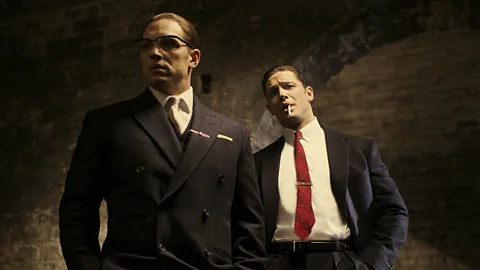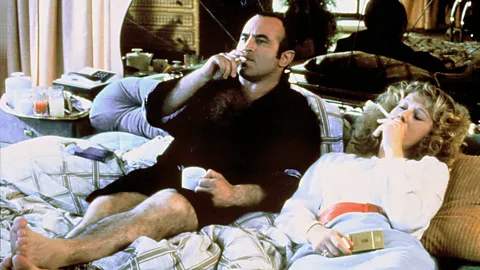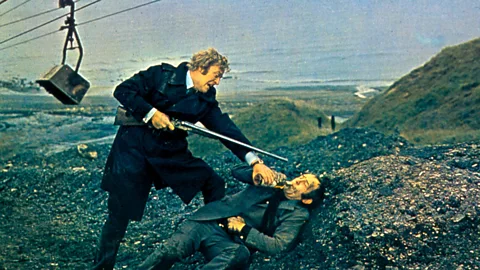Why Legend won’t be the next Scarface
 StudioCanal
StudioCanalLegend is about gangsters, but don’t expect another Scarface. Why are British film mobsters so much more fallible – and funny – than those in the US? Nicholas Barber reports.
Brian Helgeland’s new film Legend is a gangster movie, which means you can expect guns, nightclubs, sharp suits and fast cars. But it’s also a British gangster movie – so you’ll also find homoeroticism, surrealism and comedy, not to mention a tutting mother serving cups of tea.
As wildly varied as British gangster movies are, certain ingredients are stirred into most of them. Like HP sauce, these ingredients give the films their own unmistakable national flavour.
 StudioCanal
StudioCanal“To understand what a British gangster movie is, you have to understand what a Hollywood gangster movie is,” says Paul Elliott, the author of Studying the British Crime Film. “The gangster in Americans films is a mythical figure, a symbol of man’s aspiration and man’s hubris.
“He is often an immigrant rising through the ranks of the mob, and then having a tragic fall; that’s what you get in The Godfather and Scarface. These films are about people who live out the American Dream in the purest sense. They go after what they want, and they pay for it.”
This interpretation was first outlined in The Gangster as Tragic Hero, a 1948 essay by Robert Warshow. In his words, the American gangster is “what we want to be and what we are afraid we may become”. Like any self-respecting tragic hero, he is fated to a grisly demise – but first, he enjoys riches, political influence and fawning neighbours who kiss his hand at society weddings. To quote Tony Montana’s motto in Scarface, “The world is yours”.
 Moviestore Collection Ltd/Alamy
Moviestore Collection Ltd/AlamyIn British films, on the other hand, gangsters are comic figures rather than tragic ones. For them, the motto “Three Pubs and a Café Are Yours” would be more appropriate.
“We don’t have a syndicated mob system in Britain,” says Elliott. “We have a series of small gangs, so we don’t have the hierarchy you need for a mythic rise and a tragic fall. Instead, the British gangster movie concentrates on the foot-soldier, the boss of a localised gang. That’s the first thing.
“The second thing is that we like our gangsters to be a bit more fallible, a bit more absurd than the American ones.”
All blood and no glory
This preference goes all the way back to Brighton Rock, the first proper British gangster film, released in 1947. Its anti-hero Pinkie Brown (played by Richard Attenborough) is one of the greatest characters in all crime fiction. He’s also a teenage psychopath in a seaside town with a handful of past-it lieutenants.
In the Hollywood version, he’d be lucky to get a job as Vito Corleone’s shoeshine boy.
 Rex Features
Rex Features“The British gangster is not glamorous,” says Andrew Spicer, author of the book European Film Noir. “He’s an overreacher and a vainglorious braggart, and the film pulls him back into the sordid milieu from which he came.”
This essential low-rent grubbiness applies even to Harold Shand. Played by Bob Hoskins, he is the potato-faced Mr Big in that most beloved of British gangster films, The Long Good Friday (1980). It’s clear that Shand has ruled London’s gangland for a decade – but it’s also clear that he’s something of a joke. He hands out guns to his men on the condition that they return them at the end of the evening. His tacky flat bears a distinct resemblance to Del Boy Trotter’s in the BBC sitcom Only Fools & Horses.
 AF archive/Alamy Stock Photo
AF archive/Alamy Stock PhotoAnd, crucially, he looks like Bob Hoskins. “He’s no Ray Liotta, is he?” says Elliott. “He’s short, fat and bald. And he’s usually standing next to Helen Mirren, which makes him seem even shorter, fatter and balder.”
We are Legend
The bathetic side of the British gangster is there in Legend, too. Helgeland’s film is a biopic of Ronnie and Reggie Kray, the identical twins who terrorised London in the 1960s while maintaining their image as clean-cut club owners. Photographed by David Bailey and still idolised in some quarters, the Krays are as glamorous as British gangsters get.
They’re even more glamorous on film: in Legend, trick photography allows the pouting Tom Hardy to play both twins, and in the 1990 biopic The Krays, the title roles went to Spandau Ballet’s heartthrobs Martin and Gary Kemp.
All the same, no one’s going to get them mixed up with Tony Montana. In the 1990 film, for example, the twins are overgrown schoolboys who hold their war councils upstairs in their mother’s terraced house.
“I’ve visited the main landmarks that are used in Legend,” says Damon Wise, a London-based film critic. “I went to the Krays’ house, their local pub, the cafe where they ate every day and the church where Reggie got married. And the interesting thing is they’re all right next to each other. In Hollywood, Warner Bros could tell big international stories, with characters based on Meyer Lansky” – the so-called ‘Mob’s ant’ – “going from Belarus to New York to Las Vegas.
 StudioCanal
StudioCanal“You can’t do that in Britain. The Krays started in the East End of London, and the West End is as far as they ever got.”
Getting schooled
If British film gangsters have never had the grandeur of American ones, it’s not for want of trying. Again and again, they struggle to measure up to their transatlantic counterparts, as with Shand striving to secure US backing for his property development scheme.
According to Steve Chibnall, the author of British Crime Cinema, this special relationship is rooted in reality. “It’s well documented that British gangsters learned how to present themselves by watching American gangster movies,” he says. “The Krays, in particular, wrote about how they copied their tailoring and their mannerisms from George Raft. That’s one of the reasons they took over a gambling club called Esmeralda’s Barn. They wanted a speakeasy like the ones they’d seen in the movies.”
 Moviestore collection Ltd/Alamy
Moviestore collection Ltd/AlamyThis is a recurring theme in British gangster films: the suggestion that the characters are playing a part, straining to be something they’re not – and often lusting to be like their role models. In the 2000 film Gangster No 1, the unnamed protagonist (played by Paul Bettany) craves the clothing worn by his dapper mentor (David Thewlis), up to and including a tie-pin bearing the older man’s initials. In 1970’s Performance, James Fox’s vicious mob enforcer adopts the long hair and kaftan of Mick Jagger’s reclusive pop star.
In Guy Ritchie’s 1998 movie Lock, Stock and Two Smoking Barrels, the gangster-as-actor trend goes even further. “In Ritchie’s films, he’ll sometimes cast genuine former gangsters as versions of themselves,” notes Elliott, “so you get the weird circularity of a gangster who used to play that role in real life, now playing the role of someone who is playing that role.”
Mind-bending mob movies
Because British movie gangsters don’t live out the American Dream, they just dream about it – hence the psychedelia that seeps into what would otherwise be the most down-to-earth of genres. For every film with the grit of 1971’s Get Carter, there’s another that infuses kitchen-sink squalor with disorienting trippiness, from the colour-coded tableaux of Peter Greenaway’s 1989 The Cook, The Thief, His Wife and Her Lover to the opening reverie of a cocaine-stocked pharmacy in 2004’s Layer Cake.
Just as the movies’ characters have to reinvent themselves because they don’t come from long-established Mafia families, the films can experiment because they don’t belong to a long-established genre.
 Pictorial Press Ltd / Alamy Stock Photo
Pictorial Press Ltd / Alamy Stock PhotoIn recent years, some of that experimental flair has faded. After being re-energised by Guy Ritchie at the end of 1990s, his many imitators latched onto his films’ blokey machismo and cartoonish violence, forgetting the postmodern wit and structural tricks that went with them. As a result, the past decade has meant a murky stream of low-budget direct-to-DVD capers, usually involving a drug deal gone wrong in an Essex pub carpark.
Let’s hope that Legend reminds directors of how much more can be done. The British gangster film may never reach the elevated status of a classical tragedy – but it’s capable of almost anything else.
This story is part of British film week, a series running on BBC Culture and BBC Britain. If you would like to comment on this story or anything else you have seen on BBC Culture, head over to our Facebook page or message us on Twitter.
